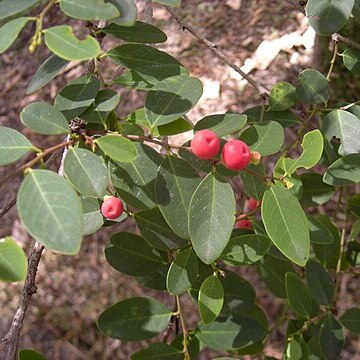Shrub to 3.5 m high. Stipules narrowly triangular, 1.3–2.2 mm long, acute or acuminate, red-brown with pale margins. Branchlet leaves: petiole 1.6–5 mm long; lamina elliptic, ovate or orbicular, 8–48 mm long, 7.5–30 mm wide, rounded or obtuse, sometimes emarginate, with margin recurved, strongly discolorous, minutely white-punctate abaxially. Inflorescence unisexual, with females distal. Male flowers 1–3 per fascicle; perianth obconical or campanulate; tube 0.8–1.2 mm long, truncate, obscurely 6-lobed; scales exserted; androphore included. Female flowers solitary; pedicels 2.2–5 mm long, scarcely elongating in fruit; perianth campanulate or turbinate, 2.5–3.5 mm diam.; tube 1–1.8 mm long; lobes c. 0.8 mm long, abruptly and shortly acuminate; ovary subglobose, c. 1.4–2 mm diam., mostly not exceeding perianth rim. Fruit subglobose, 4.5–9 mm diam., ± centrally depressed, pink–red, turning black; fruiting perianth discoid, 3.2–6 mm diam., red. Seeds 4–4.6 mm long, brown.
More
A shrub. It grows about 3 m tall. The bark is light brown and smooth. The leaves are simple and alternate. They are oval and entire. They are 3.5 cm long. They are green above and more pale underneath. The flowers are small and green to yellow. The fruit are berries about 6 mm across. They are pink to red and turn black as they ripen.
Grows in Eucalyptus forest or woodland, rainforest margins or dry rainforest on a variety of substrates including sandstone, shale, granite and basalt.
More
It is a tropical to warm temperate plant. It grows in rainforests.


